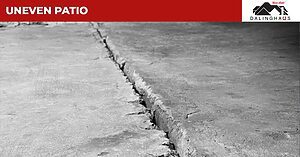Have you ever stepped outside only to notice that your once-perfectly level concrete patio has now become completely uneven? If so, you’ll likely be wondering what to do next.
The answer to your problem is to find a way to raise your patio to make it level once more and restore its functionality. In this article, we’ll explain the reasons why concrete becomes unlevel in the first place, then discuss some of the details about what it takes to repair a concrete patio by raising it.
Why Does Concrete Become Unlevel?

The most common reason why concrete becomes unlevel is that the soil below it has sunk or shifted. When soil below concrete shifts, it often leaves behind an empty space. Since the concrete depends on the soil for support, it will eventually sink into the empty space the soil left behind.
When this happens, your concrete will become unlevel, and may even crack. Both of those outcomes not only make your concrete difficult to use, but also present a trip hazard. Because this is the case, it’s important to repair your unlevel concrete as soon as you can. The next section will teach you how that process unfolds.
Raising and Leveling Concrete Slabs
Raising a concrete slab is a detailed process that requires a few specific steps. The next few subsections will explain what is involved in each of those important stages. While the actual job of concrete leveling is far more in-depth, the information below will give you a general idea of what occurs during this type of project.

Evaluate Your Unlevel Concrete
The first step when raising a concrete patio is to make a visual assessment. During this stage, it is important to identify the specific areas of your patio that have sunk the most. These areas are where most of the raising should take place.
Raising areas of your concrete that don’t need to be raised will only make the problem worse. Being strategic at this stage will help you identify the areas of your concrete that need to rise up, and will allow the following steps to take place as smoothly as possible.
Drill Holes Through the Concrete Slab
The next step when raising a concrete slab is to drill holes through the top of the concrete. Drill holes in the areas of the concrete that require the most lift, which you should have identified in step one. Drilling holes provide a clear access point for the injection material that’s required for the next step.
Inject Leveling Material
This step is the one where the actual raising of your concrete takes place. At this stage, it’s time to inject concrete leveling material into the drilled holes. By doing so, the material will fill the empty spaces below the concrete, raise the slab, and provide support for the slab to remain in place.
Wait for the Leveling Material to Dry
After raising your concrete by injecting a leveling material, the final step is to wait for that material to dry and harden. If you choose polyjacking, the curing process will occur in just a few minutes. Once it is dry, your concrete patio will be level and stable once again.
Should You Raise Your Concrete Patio Yourself?
After reading through the previous section, you likely feel like you have a firm understanding of what it takes to raise concrete. You may even be tempted to perform this job on your own. However, taking this DIY approach is not always the best option.
Instead, raising a concrete patio is something you should hire a professional to do. The concrete leveling process requires special equipment and materials. It is also difficult to do correctly if you lack experience. Additionally, attempting to raise concrete without proper skills, tools, and experience is a safety hazard.
If you want to have your concrete patio leveled as efficiently and safely as possible, you should always seek the help of a professional. A concrete expert will be able to raise your patio effectively and ensure it remains stable for years to come.
How Much Does It Cost to Raise a Concrete Patio?
Now that you know that leveling concrete is something you should not do on your own, you’re probably wondering how much it will cost to have a professional level your concrete. As you might guess, the exact cost of one of these projects depends on the size of your patio and the severity of the unlevelness. The leveling material used will also play a role in the overall cost.
With that said, there are some figures we can provide to give you an idea of what this project will cost. For example, polyjacking costs about $25 per square foot.
Learning the cost of polyjacking causes many people to consider doing it on their own. If you feel this urge, however, remember that leveling concrete is dangerous, and may not be successful if you don’t have the right experience. As such, hiring a professional is always the best approach.
Hire a Team to Raise Your Concrete Patio
If you are dealing with an unlevel concrete patio, we’re here to help! At Dalinghaus Construction, we serve Southern California, Nevada, and Arizona with top-of-the-line concrete leveling and other services.
We have the skills and know-how to quickly and effectively level your concrete so that you can use it safely once again. To learn more about what we can offer and take advantage of our free evaluations, reach out to us today!






